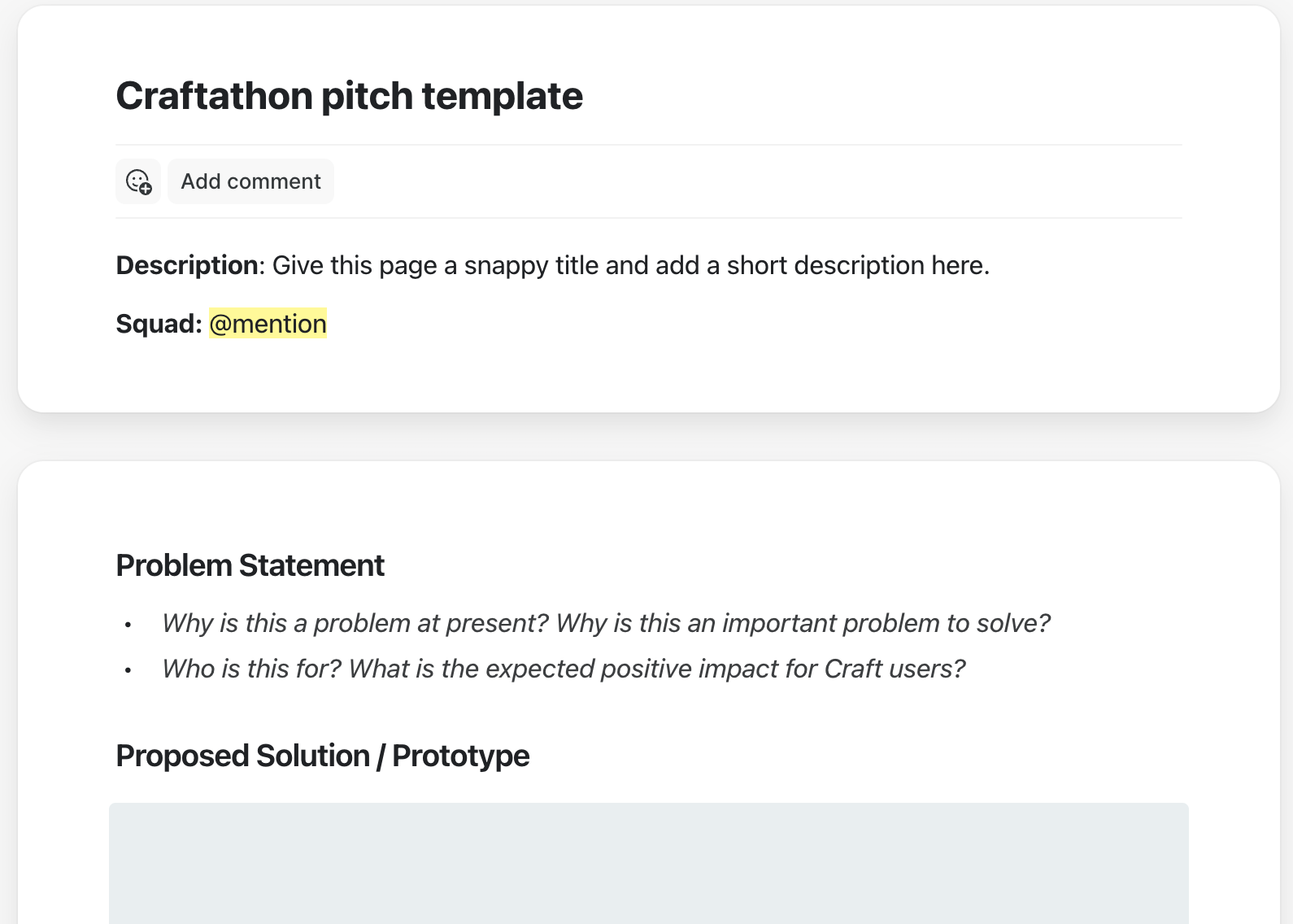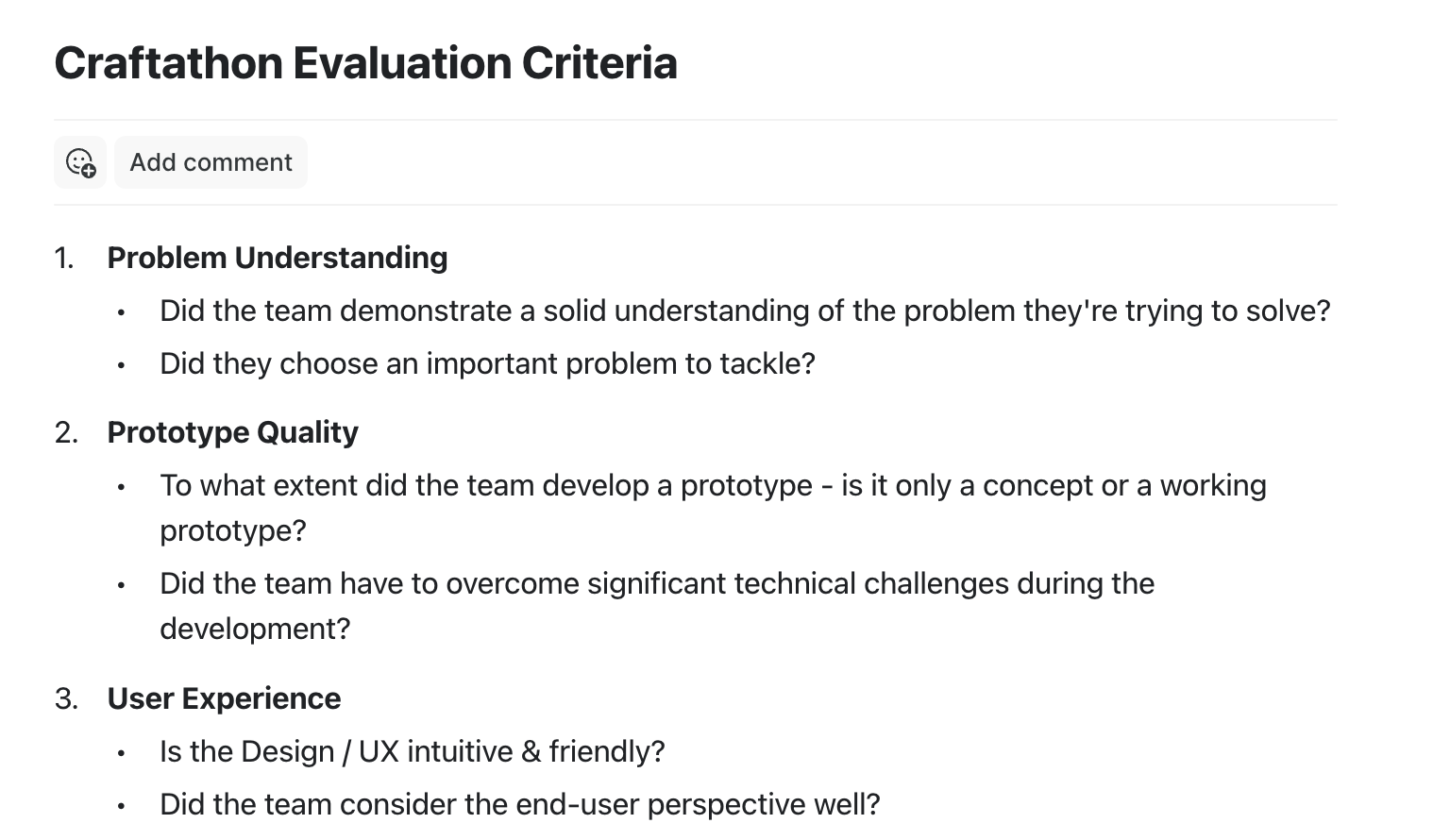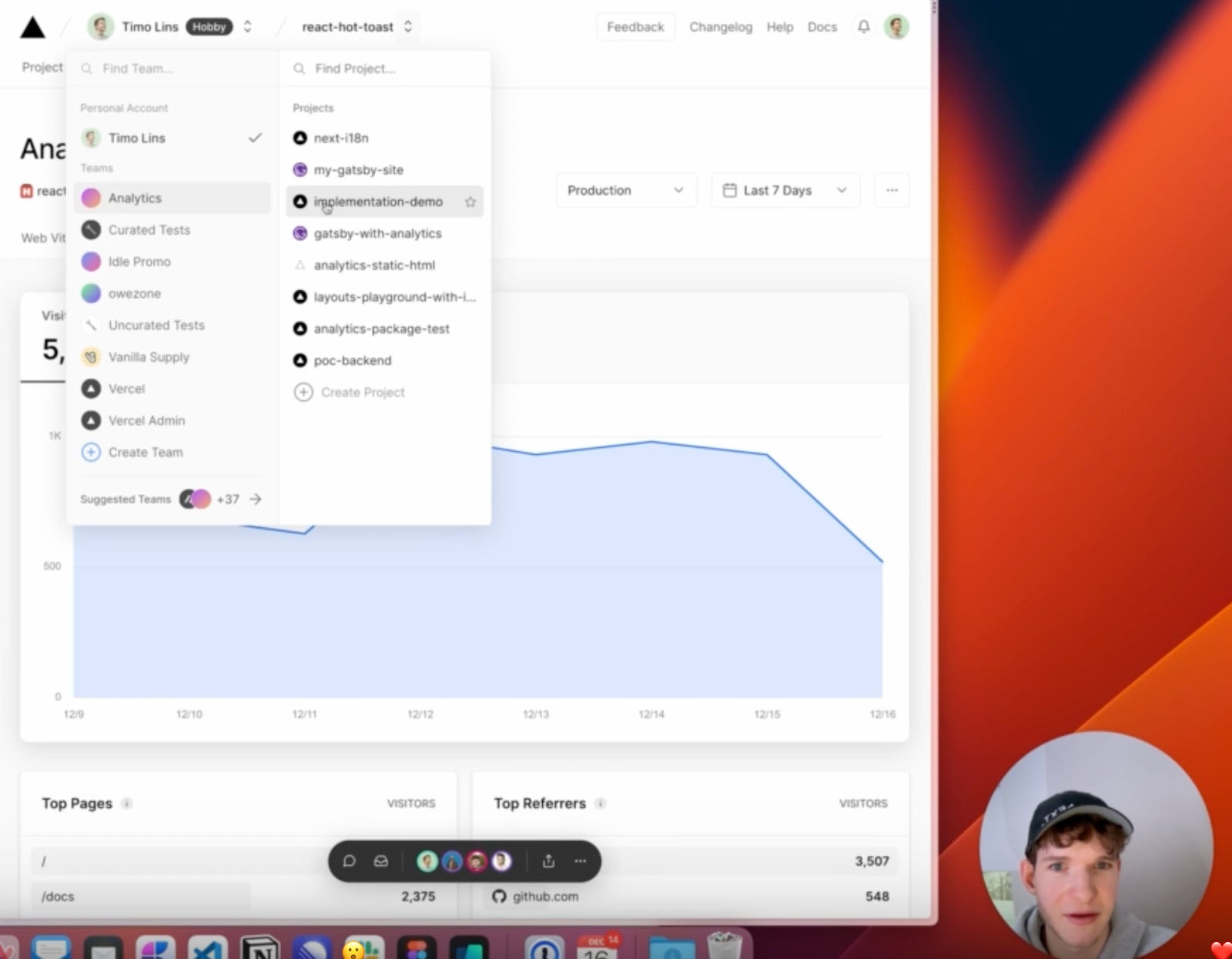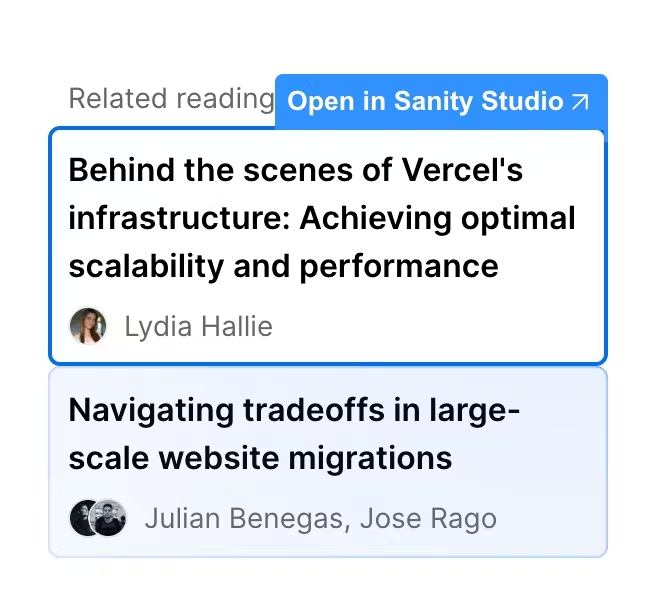👋 Hi, this is Gergely with a subscriber-only issue of the Pragmatic Engineer Newsletter. In every issue, I cover challenges at Big Tech and startups through the lens of engineering managers and senior engineers. If you’ve been forwarded this email, you can subscribe here. Organizing and Running Successful HackathonsHackathons are fun for engineers, beneficial for businesses, and a good way to shake things up. This article suggests approaches for running successful hackathons – and whether you should hold one.In September last year, I was asked to be a judge at a hackathon organized by my brother’s startup, Craft Docs; a 50-person Series B company. The theme of the hackathon was – unsurprisingly – experimenting with Artificial Intelligence (AI,) and was the company’s biggest-ever hackathon. I’ve done plenty of hackathons; some memorable, some underwhelming. This event was one of the best I’ve seen: with around 80% of staff taking part, including designers, product managers, and customer support representatives within engineering teams. The winning team consisted of some customer support folks and engineers, who built tooling which improved the customer support team’s workflow by solving some persistent pain points. How did this startup pull off such a well-run hackathon, and how can other companies do so? I turned to the organizers of successful hackathons to learn which approaches worked for them. Today, we cover:
The bottom of this issue could be cut off in some email clients. Read the full article uninterrupted, online. 1. AI hackathon at Craft DocsMarin Dimitrov is director of engineering at Craft Docs (we were also colleagues at Uber,) and he organized this hackathon. Turns out, it was not as carefully planned as I’d assumed – and such an event isn’t a regular thing at the company. Marin says:
GoalsHere’s the goals Marin and the organizing committee set for the hackathon – or, as they called it, the “Craftathon.”
PreparationThe Craftathon was announced 4 weeks ahead of time. The goal was to let teams self-organize, but some lightweight guidance sped up the process: 1. A pitch template. A document of guidance on how individuals can pitch ideas and attract teammates to form a squad around an idea. The pitch had to outline important details like the problem statement, proposed solution, resources needed (e.g. datasets, third-party API access, budgets,) as well as the vision for the prototype and how it could be productised by Craft). Here’s the pitch template – created in Craft, of course!
2. Forming hackathon squads. As a constraint, every idea had to have at least 2 enthusiasts working on it, and nobody was to work alone. Without this constraint, the relationship-building goal would have been hard to meet. Thanks to this constraint, some ideas with only one supporter were merged into a bigger project. 3. The leadership team encouraged people to take part. Within each function, leaders created space and offered motivation for people to sign up for the event. It was voluntary, but if someone couldn’t commit due to work commitments, then leadership tried to find ways to free up their time. 4. Encourage non-engineers to pitch ideas. The problem with aiming for inclusive teams is that to get a realistic shot at winning one of the monetary prizes, the winning team had to have engineers to create a working prototype. But where would this leave teams with only one engineer, or none? To make the event more inclusive, one of the three monetary prizes were reserved for the squad that came up with the best idea, design and presentation – even if the idea did not have a working prototype! This was deliberately done to encourage non-engineers to pitch ideas. And it worked! Recruiters and customer support got involved in surprisingly high numbers, pitched ideas, and attracted engineers to many of their ideas! In the end, every hackathon squad had an engineer and a working prototype! Running the CraftathonThe event took 2.5 days: two days of building, and half a day of demos and evaluation. The building days were protected as uninterrupted time for all participants. Release schedules, ETAs, and plans were adjusted in advance for all teams and functions. The company also provided breakfast, lunch and dinner for everyone in the office for the duration of the Craftathon, so that the ideation, discussions and excitement were not disrupted. Everyone co-located for the hackathon: this was because on Day 3, a new office opening party was scheduled. The whole team was already in the Budapest offices, which created intense, efficient in-person brainstorming & collaboration. Enabling teams to move faster took some additional preparation and extra work. A couple of engineers volunteered to do additional work in advance, so that they enabled the Craftathon squads with things like:
Demos and evaluationThe final demos and evaluation was the “goal” of the hackathon. Naturally, this required some organization:
A 1-page evaluation summary: each team received this afterwards from the committee, providing detailed feedback on their idea, the completeness and quality of the prototype, as well as the demo & presentation quality. The feedback was open to view for the whole company and it included the video of the presentation (for those to view who might have missed it,) a highlights section, feedback on the idea, and on the presentation. Outcome and next stepsHere’s how Marin summarizes his experience of the hackathon:
My observationsAs a guest and invited judge at this hackathon, what stood out to me was the cross-functional engagement. Team after team, marketers, recruiters, and product folks, demoed what they’d built together with engineers. Talking to the teams, many had worked together for the first time, and it felt like this event doubled as an intense team building exercise. Even though the theme of the hackathon was AI, and it’s pretty easy to do creative things with these tools, I was still surprised just how much “practical creativity” was on display. There was a team building a tool to “score” a document and offer improvements, another team built a better search with the tool while discovering clever ways to use ChatGPT to give better search results than the “simple approaches,” and there was even a team that created “Craft Radio:” a podcast version of daily team updates, read by the AI-synthesized voice of team members! Interestingly, having several real prizes seemed to create a bit of competitive spirit where teams pushed hard to make their ideas more production-ready. In most hackathons, there are teams that you can tell are there to have fun; but here, all teams had good ideas and executed on them surprisingly well in the two days. I was especially impressed by how integrating GenAI features didn’t seem to be a problem for most teams. One thing that I was left wondering: was the hackathon so successful thanks to all the bottom-up experimentation which generative AI opens up? My suspicion is that this was a big driver. On the other hand, I can’t deny the hackathon was smartly organized, and took advantage of an inflow of energy with the whole company coming together, which usually only happens once a year. For more on this event, the Craft team published their own summary of this hackathon. 2. Vercel’s annual hackathonVercel is the leading frontend cloud platform, and creator of the popular Next.js frontend framework, with around 400-500 members of staff. VP of Engineering, Lindsey Simon, shared a few details about how Vercel runs its annual, internal hackathon. Timing-wise, it takes place two to three weeks after the annual, flagship Next.js conference, usually in November or December, and lasts a week. Here’s the briefing participants are given, as shared by Lindsey:
Hackathons are sources of innovation at Vercel, Lindsey told me, due to a focus on building something shippable. Successful projects become new features which go to production. Here are a couple that were born out of a hackathon: The "PowerPicker": An UI tweak for a “smarter” navigation bar. It’s a tweak that makes the “parent” menu item hold focus even after navigating to the “child” item. In the image above, “Analytics” parent menu is visually selected, despite the mouse being above the “implementation-demo” child item. Before this change, “Analytics” would have been de-selected. It’s a seemingly simple UI tweak that is both useful and complicated to build. Vercel Cron: Schedule tasks and automate workflows in seconds. Use cases include triggering updates to and from third-party APIs, monitoring service health, running critical jobs like data backups, and more. Launched in February 2023, after a fall 2022 hackathon. CMS Editing: Old pages built with Vercel’s content management system (CMS) functionality could only be edited within the CMS itself. A hackathon project prototyped what it would be like to edit in-place, instead. This was how the Visual Editing feature was born at the 2022 hackathon, and launched in 2023.
Layout Shift tool within the Vercel Toolbar: A layout shift is when a visible element changes position between two render frames, which makes the webpage seem “jerky” and disorienting for users. This hackathon project built a tool to automatically detect shifts and report them to customers. This feature was built during an October 2023 hackathon, and shipped just a month later.
A Date Formatting Library: A platform called little-date was started at an October 2023 hackathon, and published in February 2024. From the project’s documentation:
AI Help First on Vercel’s help page. Before submitting a ticket to Vercel’s customer support (CS) team, an AI service trained on the Vercel and Next.js documentation answers the question (see recent Klarna blog post.) The results so far show that 20% of requests are successfully answered by the AI. Additionally, if the answer is insufficient the AI automatically prefills the ticket submission form by analyzing the user’s described question/problem; saving time and better routing the customer to get help from the CS team. “Friday Demo Days” are intended to keep “hacking” culture alive: Every Friday, anyone can get feedback on something they are building. The idea is to give people space to innovate outside of annual hackathons, and to infuse some of the hackathon spirit into daily work. 3. “Explorers” hackathons at Cabify...Subscribe to The Pragmatic Engineer to read the rest.Become a paying subscriber of The Pragmatic Engineer to get access to this post and other subscriber-only content. A subscription gets you:
|
Search thousands of free JavaScript snippets that you can quickly copy and paste into your web pages. Get free JavaScript tutorials, references, code, menus, calendars, popup windows, games, and much more.
Organizing and Running Successful Hackathons
Subscribe to:
Post Comments (Atom)
When Bad People Make Good Art
I offer six guidelines on cancel culture ͏ ͏ ͏ ͏ ͏ ͏ ͏ ͏ ͏ ͏ ͏ ͏ ͏ ͏ ͏...
-
code.gs // 1. Enter sheet name where data is to be written below var SHEET_NAME = "Sheet1" ; // 2. Run > setup // // 3....








No comments:
Post a Comment